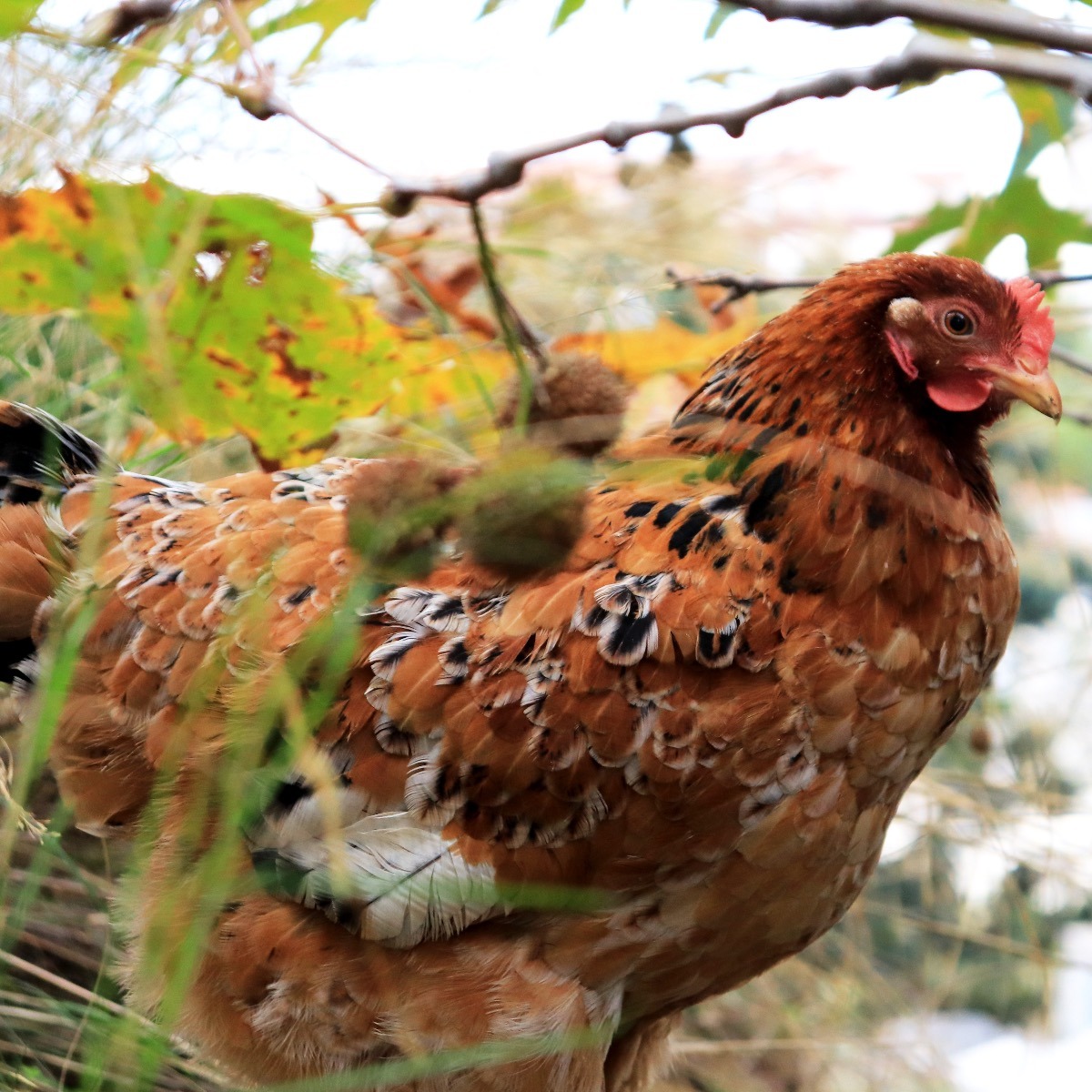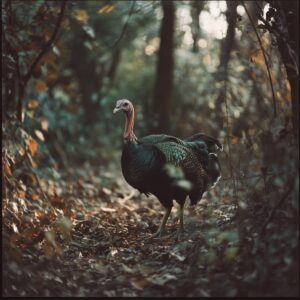How far can a chicken fly?
Growing up, we had chickens, and I remember them flying up into the surrounding trees if they got out of their coop or pen. So yes, chickens can fly, but let’s look at their capabilities more carefully.
While chickens are not known for their long-distance flights, they can cover short distances through brief bursts of flight. On average, a chicken’s flight capabilities typically extend to a maximum distance of about 50 meters (164 feet). However, it’s important to note that individual chickens may vary in their flying abilities due to breed, size, and overall health.
Short, low flights generally characterize the flight of a chicken. They use their wings to generate thrust and take off from the ground or a low perch. Chickens can achieve a modest height during flight, reaching around 3 to 4 meters (9 to 13 feet) above the ground. However, they are not capable of sustained or prolonged flight like many other bird species.
Domestication Status
It’s worth mentioning that the ability of chickens to fly may also depend on their domestication status. Wild or junglefowl ancestors of chickens, such as the red junglefowl, possessed more developed flying abilities as they relied on flight for survival in their natural habitats.
Selective breeding and domestication of chickens over generations have led to changes in their flight capabilities. Modern domesticated chickens have been selectively bred for specific traits like meat production, docility, and egg-laying, often resulting in reduced flight abilities. Their increased body weight and alterations in wing structure have further limited their flight capacity.
It is essential to provide chickens with enough space and opportunities for exercise to maintain their flight muscles. Enclosures that allow for vertical perching and short flights promote their natural behavior and keep their flight skills active to some extent.

Why do chickens fly?
- Predation Avoidance: One of the primary reasons chickens fly is to escape potential predators. When they sense danger or perceive a threat, they may take flight to seek safety in higher ground or inaccessible areas where predators are less likely to reach them.
- Roosting and Resting: Chickens naturally tend to roost and rest at elevated locations, such as tree branches. Flying allows them to reach higher perches where they can find a secure and comfortable place to rest, away from potential disturbances on the ground.
- Foraging and Food Access: Chickens may use flight to access food sources that are not easily reachable from the ground. By flying to elevated areas or trees, they can access fruits, berries, or insects out of reach at ground level, expanding their foraging opportunities.
- Exploration and Territory Expansion: Flight enables chickens to explore and expand their territory. They may fly short distances to investigate new surroundings, seek out resources, or establish their dominance in a new area. This behavior is more commonly observed in free-range or wild chicken populations.
- Courtship and Mating: Roosters may engage in short flights as part of their courtship behavior. They may fly to higher points to showcase their dominance, attract hens, or engage in wing-flapping or crowing displays to assert their presence and establish mating opportunities.
Do farmers clip chicken wings so they don’t fly away?
Yes, it is common for farmers and poultry keepers to clip chickens’ wings to prevent them from flying away. Wing clipping is a practice that involves trimming or removing a portion of the primary flight feathers on one or both wings of a chicken. By doing so, the bird’s ability to generate lift and sustain flight is significantly reduced.
The primary purpose of wing clipping is to ensure the safety and containment of the flock. Chickens allowed to fly freely may escape from enclosures or venture into areas where they could be exposed to predators, accidents, or other hazards. Wing clipping helps to keep chickens within a designated space and reduces the risk of loss or harm.
Wing clipping should be performed with care and precision to avoid causing unnecessary pain or injury to the chicken. It is typically done when the birds are young, and their feathers are still growing.
The process involves trimming the primary feathers on one wing, which creates an imbalance in flight and prevents the bird from achieving full lift during takeoff. This imbalance makes flying difficult, discouraging escape attempts without affecting the bird’s health.
It’s important to note that wing clipping is temporary, as the trimmed feathers will eventually molt and be replaced by new ones. The feathers will grow back, restoring the bird’s ability to fly. Regular monitoring and re-clipping may be necessary to maintain containment if desired.

Alternative Solutions
While wing clipping is a widely practiced method, alternative approaches to managing chicken flight exist. Some poultry keepers opt for providing adequate enclosure designs that discourage flying out, such as higher fences or netting. Additionally, offering sufficient space, perches, and engaging environments can help reduce the urge to fly and promote the birds’ overall well-being.
Ultimately, the decision to clip a chicken’s wings depends on the specific circumstances and goals of the poultry keeper. It is important to prioritize the welfare and safety of the birds while ensuring they can be managed effectively within their environment.
How do you get a chicken out of a tree?
I remember as a kid, when the chickens got out of their coop or pen, they would sometimes fly up into the neighboring trees. My father would be furious at the person who left the gate open because getting them back into the pen was incredibly difficult.
He did not follow the advice given below but would put the garden hose on them and it worked, but I don’t think the chickens appreciated it. Here are some tips to do it the right way.
- Assess the Situation: Observe the chicken’s location and assess the height and stability of the branch they are perched on. Ensure your safety, considering potential hazards or risks in accessing the chicken.
- Provide an Alternative Perch: Chickens often fly to higher branches seeking a safe, elevated roosting spot. To encourage them to come down, you can try providing an alternative perch at a lower and easily accessible location. Use a ladder or sturdy object to create a temporary roost or platform near the tree’s base. Place some food or treats on the alternative perch to entice the chicken to come down.
- Use Gentle Encouragement: Approach the tree calmly and quietly. Avoid sudden movements or loud noises that may startle the chicken and cause it to fly higher. Speak softly and use a soothing tone to coax the chicken down. You can also try calling them by name if they are familiar.
- Use a Long Pole or Ladder: If the chicken is within reach but still hesitant to come down, you can use a long pole or a ladder to gently nudge or guide them toward the alternative perch or a lower branch. Be careful not to frighten or harm the chicken in the process.
- Wait Patiently: Chickens may feel more comfortable and confident coming down from the tree on their own once they realize the alternative perch or lower branches are safe and accessible. Give them time and space, maintaining a watchful eye to ensure their well-being.
It’s important to note that climbing trees or using tools to reach higher branches can be dangerous. Suppose the chicken is unreachable or seems distressed. In that case, it may be best to seek assistance from arborists, animal control, or experienced poultry keepers with the necessary equipment and expertise to retrieve the chicken safely.
Preventing chickens from flying up trees in the first place can be achieved by providing suitable elevated roosting options within their designated enclosure, ensuring they have comfortable and secure places to rest and roost at ground level. As discussed earlier, regular wing clipping can also help limit their flying abilities and discourage them from reaching higher branches.
Please remember to prioritize the safety and well-being of yourself and the chicken when trying to get them down from a tree.

Does one breed fly better than others?
Yes, some chicken breeds have better flying abilities than others. The flying capabilities of chickens can vary depending on their breed, size, body structure, and genetic traits. While most modern domesticated chicken breeds have reduced flight capabilities compared to their wild ancestors, there are still variations among different breeds.
Certain chicken breeds retain more ancestral flying traits and are known to be better flyers. These breeds tend to have lighter body weights, well-developed flight muscles, and longer wings, which enable them to achieve greater heights and cover longer distances during flight. Examples of chicken breeds known for their relatively better flying abilities include:
- Game Fowl: Game fowl breeds, such as Old English Game or American Game, have a strong flight instinct and retain more of their natural flying capabilities. They are agile and can achieve significant heights during flight.
- Junglefowl Crosses: Crossbreeds between domesticated chickens and their wild relatives, like the red junglefowl, may exhibit improved flying abilities due to the genetic influence of the wild ancestor. These crosses often retain some of the flight characteristics of their junglefowl ancestors.
- Bantam Breeds: Bantam chickens, miniature versions of standard-sized breeds, tend to be lighter and more agile. Some bantam breeds, like the Sebright or the Japanese bantam, are known for their relatively better flying abilities than larger chicken breeds.
On the other hand, certain chicken breeds have been selectively bred for specific traits, such as size, meat production, or egg-laying, which often result in reduced flight capabilities. These breeds may have heavier body weights, shorter wings, or less developed flight muscles, making sustained flight more challenging.
Examples of such breeds include commercial broilers, large meat breeds like the Cornish Cross, and some heavy-bodied laying breeds like the Orpington.
Understanding the flying capabilities of different chicken breeds can be helpful for poultry keepers interested in specific traits or managing their flocks in specific settings. However, it is essential to provide appropriate care and management practices for all chicken breeds, irrespective of their flying abilities, to ensure their well-being.
What about roosters?

Roosters, being male chickens, generally have similar flying abilities to hens of the same breed. However, there are a few essential factors to consider when it comes to roosters and their flying capabilities:
- Size and Weight: Roosters, particularly of larger or heavier breeds, may have slightly reduced flying abilities compared to hens of the same breed due to their larger size and weight. The extra bulk can make the sustained flight more challenging.
- Dominance and Behavior: Roosters are often more active and assertive than hens. They may engage in short flights as part of their natural behavior, such as chasing other roosters or asserting dominance within the flock. Their flight tends to be purposeful and aimed at maneuvering within their environment rather than covering long distances.
- Wing Spur Usage: Some roosters develop sharp spurs on their wings, located near the wrists. These spurs are not used for flying but instead serve as weapons for defense or establishing dominance. Roosters may use their wings during displays of aggression or territoriality, but not necessarily for extended flight.
- Breed Variations: Similar to hens, rooster breeds may exhibit variations in their flying abilities. Breeds with a more robust flight instinct or those descended from wild junglefowl may have better flying skills than breeds selectively bred for specific traits, such as meat production or show qualities.















